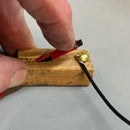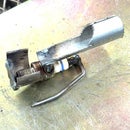Introduction: Wear Edge for a Plastic Snow Shovel
Our plastic snow shovel works well, but I wanted a steel wear edge to handle snow "glued" to the concrete after freezing rain and to prolong the life of the shovel. We are somewhat "snowed in" right now, so I wanted to use materials in my shop. I chose to use some steel from an old bedframe because it is so hard and will wear very well.
In the photo the wear edge is not finished, but only ready for fitting.
Materials
In the photo the wear edge is not finished, but only ready for fitting.
Materials
- Angle iron from a bed frame
- 1/4 inch bolts and nuts
- Angle head grinder, cutting and grinding wheels
- Measuring and marking tools
- Vise-Grip pliers
- Keyhole saw with a fine blade
- File
- Flux core wire feed welder and 230 volt stick welder
- Wrenches
Step 1: Make Flats From Angle Iron
I had angle iron from a bed frame. I needed flat stock. I put angle iron in a vise and used a cutting wheel to make two flats from one angle iron piece.
Step 2: Mark and Cut the Shovel Edge to Make It Straight
I cut one of the flats to length to fit the leading edge of the shovel. I used a pair of Vise-Grip pliers to hold that flat in place so I could mark a straight line across the ragged front edge of the shovel.
Then I cut on the marking line with a fine saw. (Second photo. The saw is from a previous Instructable I did. In this Instructable I showed how I fitted a blade from a common reciprocating construction saw.) Use a file as necessary to make the fit between the edge of the flat and the front of the shovel fairly close.
Then I cut on the marking line with a fine saw. (Second photo. The saw is from a previous Instructable I did. In this Instructable I showed how I fitted a blade from a common reciprocating construction saw.) Use a file as necessary to make the fit between the edge of the flat and the front of the shovel fairly close.
Step 3: Cut and Weld Shorter Mounting Pieces
The second flat from the angle iron became raw material for mounting pieces 4 1/2 inches long. I wanted them long enough to spread out the stress from use of the shovel in hopes that will keep the plastic from cracking around the mounting holes in the future. I marked and ground away the paint where the mounting pieces were to be welded so the welds would be better. I fitted and clamped one mounting piece. Then I welded it on another bench away from the plastic shovel. I let the weld cool so the heat would not melt or damage the plastic shovel. Then I fitted and clamped the next mounting piece, welded it on another bench, and let it cool. I did this until all four mounting pieces were welded in place. (See the photo in the Introduction. The center two mounting pieces needed to be a little thinner on one end to fit between the ribs in the plastic shovel. I sliced off a corner on each with the cutting wheel.)
Step 4: Making Holes in Bed Frame Steel
The steel used in bed frames is very hard. Making holes in it with a twist drill is very, very slow. Some suggest using a carbide tip drill and plenty of cutting oil. That did not help me.
I decided to make holes by plug welding with a high amperage setting on a 230 volt stick welder using a 1/8 inch welding rod. (See the second photo.) 120 amps would be a reasonable setting for normal welding with a 1/8 inch rod. I set my welder to about 175 amps. (See the left amperage scale for the "High" range readings. The wheel kit on this welder is from a previous Instructable I did.)
Plug welding involves using the tap method rather than the scratch method to strike an arc where you want the hole to be. A little practice is necessary, but the idea is to push through the molten metal in the weld puddle to make a hole, and do so without sticking the rod. This results in a hole the diameter of the welding rod. I wanted to attach my wear strip with 1/4 inch bolts, so I used plug welding to poke around the edge of the original hole and enlarge it. I used a grinding wheel to remove any rounded ridges from the molten metal. (Plug welding is handy if you need to mount an electrical outlet box on a steel beam. Strike an arc and push through the box so a molten pool forms in the surface of the beam. Then back the arc out so the hardened metal overlaps the outer surface of the outlet box's surface.)
I decided to make holes by plug welding with a high amperage setting on a 230 volt stick welder using a 1/8 inch welding rod. (See the second photo.) 120 amps would be a reasonable setting for normal welding with a 1/8 inch rod. I set my welder to about 175 amps. (See the left amperage scale for the "High" range readings. The wheel kit on this welder is from a previous Instructable I did.)
Plug welding involves using the tap method rather than the scratch method to strike an arc where you want the hole to be. A little practice is necessary, but the idea is to push through the molten metal in the weld puddle to make a hole, and do so without sticking the rod. This results in a hole the diameter of the welding rod. I wanted to attach my wear strip with 1/4 inch bolts, so I used plug welding to poke around the edge of the original hole and enlarge it. I used a grinding wheel to remove any rounded ridges from the molten metal. (Plug welding is handy if you need to mount an electrical outlet box on a steel beam. Strike an arc and push through the box so a molten pool forms in the surface of the beam. Then back the arc out so the hardened metal overlaps the outer surface of the outlet box's surface.)
Step 5: Drill Mounting Holes in the Plastic
Position the wear strip on the plastic shovel. Drill a 1/4 inch mounting hole. See the next step.
Step 6: Make Strain Relief Washers
I used some flat stock from the angle iron to make strain relief washers for the backside of the plastic shovel. Each is about 2 1/2 inches long.
Because the plug weld method of making holes is not completely precise the holes in the mounting pieces for the two left bolts and washers shown here were a little too far forward and I had to position the strain relief washers horizontally instead of vertically as I would have preferred.
Go back to the previous step and drill a hole for another bolt. Add a strain relief washer and bolt. Secure the nut. Repeat this process until four bolts and four strain relief washers have secured the four mounting pieces.
My bolts are too short for a lockwasher or a locking nut. The plastic compresses a tiny amount. If the nuts loosen, I will tack weld the nuts onto the screw threads to lock them in place.
Because the plug weld method of making holes is not completely precise the holes in the mounting pieces for the two left bolts and washers shown here were a little too far forward and I had to position the strain relief washers horizontally instead of vertically as I would have preferred.
Go back to the previous step and drill a hole for another bolt. Add a strain relief washer and bolt. Secure the nut. Repeat this process until four bolts and four strain relief washers have secured the four mounting pieces.
My bolts are too short for a lockwasher or a locking nut. The plastic compresses a tiny amount. If the nuts loosen, I will tack weld the nuts onto the screw threads to lock them in place.
Step 7: Use
Fortunately, the concrete on our driveway is not very cold. The chunky ice/snow mix breaks off without much difficulty. Still, if the leading edge of my snow shovel were plastic, it would not be equal to the task. But, my new steel wear strip is strong enough to break the crusted ice-snow away from the concrete. Previously, I would have needed to break the ice-snow away from the concrete with a very narrow square shovel for turning soil in a garden. And, my snow shovel will last a very long time.





